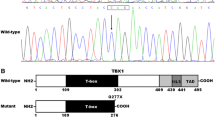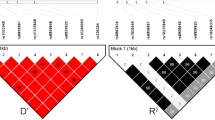Abstract
Congenital heart disease (CHD) is the most common birth defects in humans. The genetic causes for CHD remain largely unknown. T-box transcription factor 1 (TBX1), a dosage-sensitive regulator, plays a critical role in the heart development. Mutations in the coding regions of TBX1 gene have been associated to 22q11 deletion syndrome with cardiac defects and isolated CHD cases, including ventricular septal defect (VSD). To date, TBX1 gene promoter region has not been analyzed and reported in CHD patients. We hypothesized that the sequence variants within TBX1 gene promoter region may change TBX1 levels and mediate CHD development. In this study, the promoter regions of TBX1 gene were genetically and functionally analyzed in 280 VSD patients and 267 healthy controls. Two novel heterozygous variants, g.4353C>T and g.4510A>C, were found in two VSD patients, but in none of controls. The single-nucleotide polymorphism-rs41260844, g.4199T>C, was found more frequent in VSD patients than controls (P < 0.01). Functional analyses revealed that these sequence variants significantly enhanced transcriptional activities of TBX1 gene promoter. Therefore, the sequence variants within TBX1 gene promoter may contribute to the VSD etiology by altering the expression levels of TBX1 gene. Pharmaceutical or genetic manipulation of TBX1 gene expression may provide a novel personalized therapy to prevent and treat late cardiac complications for the adult CHD patients carrying these variants.


Similar content being viewed by others
References
Hoffman JI, Kaplan S (2002) The incidence of congenital heart disease. J Am Coll Cardiol 39:1890–1900
Verheugt CL, Uiterwaal CS, van der Velde ET et al (2010) Mortality in adult congenital heart disease. Eur Heart J 31:1220–1229
van der Bom T, Zomer AC, Zwinderman AH, Meijboom FJ, Bouma BJ, Mulder BJ (2011) The changing epidemiology of congenital heart disease. Nat Rev Cardiol 8:50–60
Bruneau BG (2008) The developmental genetics of congenital heart disease. Nature 451:943–948
Richards AA, Garg V (2010) Genetics of congenital heart disease. Curr Cardiol Rev 6:91–97
Buckingham M, Meilhac S, Zaffran S (2005) Building the mammalian heart from two sources of myocardial cells. Nat Rev Genet 6:826–835
Cordes KR, Srivastava D (2009) MicroRNA regulation of cardiovascular development. Circ Res 104:724–732
Rochais F, Mesbah K, Kelly RG (2009) Signaling pathways controlling second heart field development. Circ Res 104:933–942
Srivastava D (2006) Making or breaking the heart: from lineage determination to morphogenesis. Cell 126:1037–1048
van Weerd JH, Koshiba-Takeuchi K, Kwon C, Takeuchi JK (2011) Epigenetic factors and cardiac development. Cardiovasc Res 91:203–211
Naiche LA, Harrelson Z, Kelly RG, Papaioannou VE (2005) T-box genes in vertebrate development. Annu Rev Genet 39:219–239
Greulich F, Rudat C, Kispert A (2011) Mechanisms of T-box gene function in the developing heart. Cardiovasc Res 91:212–222
Xu H, Morishima M, Wylie JN et al (2004) Tbx1 has a dual role in the morphogenesis of the cardiac outflow tract. Development 131:3217–3227
Chapman DL, Garvey N, Hancock S et al (1996) Expression of the T-box family genes, Tbx1–Tbx5, during early mouse development. Dev Dyn 206:379–390
Théveniau-Ruissy M, Dandonneau M, Mesbah K, Ghez O, Mattei MG, Miquerol L, Kelly RG (2008) The del22q11.2 candidate gene Tbx1 controls regional outflow tract identity and coronary artery patterning. Circ Res 103:142–148
Zhang Z, Huynh T, Baldini A (2006) Mesodermal expression of Tbx1 is necessary and sufficient for pharyngeal arch and cardiac outflow tract development. Development 133:3587–3595
Calmont A, Ivins S, Van Bueren KL et al (2009) Tbx1 controls cardiac neural crest cell migration during arch artery development by regulating Gbx2 expression in the pharyngeal ectoderm. Development 136:3173–3183
Scambler PJ (2010) 22q11 deletion syndrome: a role for TBX1 in pharyngeal and cardiovascular development. Pediatr Cardiol 31:378–390
Paylor R, Glaser B, Mupo A et al (2006) Tbx1 haploinsufficiency is linked to behavioral disorders in mice and humans: implications for 22q11 deletion syndrome. Proc Natl Acad Sci USA 103:7729–7734
Yagi H, Furutani Y, Hamada H et al (2003) Role of TBX1 in human del22q11.2 syndrome. Lancet 362:1366–1373
Zweier C, Sticht H, Aydin-Yaylagül I, Campbell CE, Rauch A (2007) Human TBX1 missense mutations cause gain of function resulting in the same phenotype as 22q11.2 deletions. Am J Hum Genet 80:510–517
Gong W, Gottlieb S, Collins J et al (2001) Mutation analysis of TBX1 in non-deleted patients with features of DGS/VCFS or isolated cardiovascular defects. J Med Genet 38:E45
Griffin HR, Töpf A, Glen E et al (2010) Systematic survey of variants in TBX1 in non-syndromic tetralogy of Fallot identifies a novel 57 base pair deletion that reduces transcriptional activity but finds no evidence for association with common variants. Heart 96:1651–1655
Rauch R, Hofbeck M, Zweier C et al (2010) Comprehensive genotype-phenotype analysis in 230 patients with tetralogy of Fallot. J Med Genet 47:321–331
Jerome LA, Papaioannou VE (2001) DiGeorge syndrome phenotype in mice mutant for the T-box gene, TBX1. Nat Genet 27:286–291
Lindsay EA, Vitelli F, Su H et al (2001) Tbx1 haploinsufficieny in the DiGeorge syndrome region causes aortic arch defects in mice. Nature 410:97–101
Merscher S, Funke B, Epstein JA et al (2001) TBX1 is responsible for cardiovascular defects in velo-cardio-facial/DiGeorge syndrome. Cell 104:619–629
Zhang Z, Baldini A (2008) In vivo response to high-resolution variation of Tbx1 mRNA dosage. Hum Mol Genet 17:150–157
Liao J, Kochilas L, Nowotschin S et al (2004) Full spectrum of malformations in velo-cardio-facial syndrome/DiGeorge syndrome mouse models by altering Tbx1 dosage. Hum Mol Genet 13:1577–1585
Vitelli F, Huynh T, Baldini A (2009) Gain of function of Tbx1 affects pharyngeal and heart development in the mouse. Genesis 47:188–195
Chieffo C, Garvey N, Gong W et al (1997) Isolation and characterization of a gene from the DiGeorge chromosomal region homologous to the mouse Tbx1 gene. Genomics 43:267–277
Garg V, Yamagishi C, Hu T, Kathiriya IS, Yamagishi H, Srivastava D (2001) Tbx1, a DiGeorge syndrome candidate gene, is regulated by sonic hedgehog during pharyngeal arch development. Dev Biol 235:62–73
Freyer L, Morrow BE (2010) Canonical Wnt signaling modulates Tbx1, Eya1, and Six1 expression, restricting neurogenesis in the otic vesicle. Dev Dyn 239:1708–1722
Yamagishi H, Maeda J, Hu T et al (2003) Tbx1 is regulated by tissue-specific forkhead proteins through a common Sonic hedgehog-responsive enhancer. Genes Dev 17:269–281
Chen L, Fulcoli FG, Tang S, Baldini A (2009) Tbx1 regulates proliferation and differentiation of multipotent heart progenitors. Circ Res 105:842–851
Fulcoli FG, Huynh T, Scambler PJ, Baldini A (2009) Tbx1 regulates the BMP-Smad1 pathway in a transcription independent manner. PLoS One 4:e6049
Hu T, Yamagishi H, Maeda J, McAnally J, Yamagishi C, Srivastava D (2004) Tbx1 regulates fibroblast growth factors in the anterior heart field through a reinforcing autoregulatory loop involving forkhead transcription factors. Development 131:5491–5502
Ivins S, Lammerts van Beuren K, Roberts C et al (2005) Microarray analysis detects differentially expressed genes in the pharyngeal region of mice lacking Tbx1. Dev Biol 285:554–569
Liao J, Aggarwal VS, Nowotschin S, Bondarev A, Lipner S, Morrow BE (2008) Identification of downstream genetic pathways of Tbx1 in the second heart field. Dev Biol 316:524–537
Nowotschin S, Liao J, Gage PJ, Epstein JA, Campione M, Morrow BE (2006) Tbx1 affects asymmetric cardiac morphogenesis by regulating Pitx2 in the secondary heart field. Development 133:1565–1573
Pane LS, Zhang Z, Ferrentino R, Huynh T, Cutillo L, Baldini A (2012) Tbx1 is a negative modulator of Mef2c. Hum Mol Genet 21:2485–2496
van Bueren KL, Papangeli I, Rochais F et al (2010) Hes1 expression is reduced in Tbx1 null cells and is required for the development of structures affected in 22q11 deletion syndrome. Dev Biol 340:369–380
Byrd NA, Meyers EN (2005) Loss of Gbx2 results in neural crest cell patterning and pharyngeal arch artery defects in the mouse embryo. Dev Biol 284:233–245
Semina EV, Reiter R, Leysens NJ et al (1996) Cloning and characterization of a novel bicoid-related homeobox transcription factor gene, RIEG, involved in Rieger syndrome. Nat Genet 14:392–399
Watanabe Y, Miyagawa-Tomita S, Vincent SD, Kelly RG, Moon AM, Buckingham ME (2010) Role of mesodermal FGF8 and FGF10 overlaps in the development of the arterial pole of the heart and pharyngeal arch arteries. Circ Res 106:495–503
Rochais F, Dandonneau M, Mesbah K, Jarry T, Mattei MG, Kelly RG (2009) Hes1 is expressed in the second heart field and is required for outflow tract development. PLoS One 4:e6267
Acknowledgments
This study was supported by National Natural Science Foundation of China (81070173) and Shandong Provincial Natural Science Foundation (ZR2010HM111).
Author information
Authors and Affiliations
Corresponding author
Additional information
Haihua Wang, Dongfeng Chen, and Liming Ma contributed equally to this work.
Rights and permissions
About this article
Cite this article
Wang, H., Chen, D., Ma, L. et al. Genetic analysis of the TBX1 gene promoter in ventricular septal defects. Mol Cell Biochem 370, 53–58 (2012). https://doi.org/10.1007/s11010-012-1397-5
Received:
Accepted:
Published:
Issue Date:
DOI: https://doi.org/10.1007/s11010-012-1397-5




